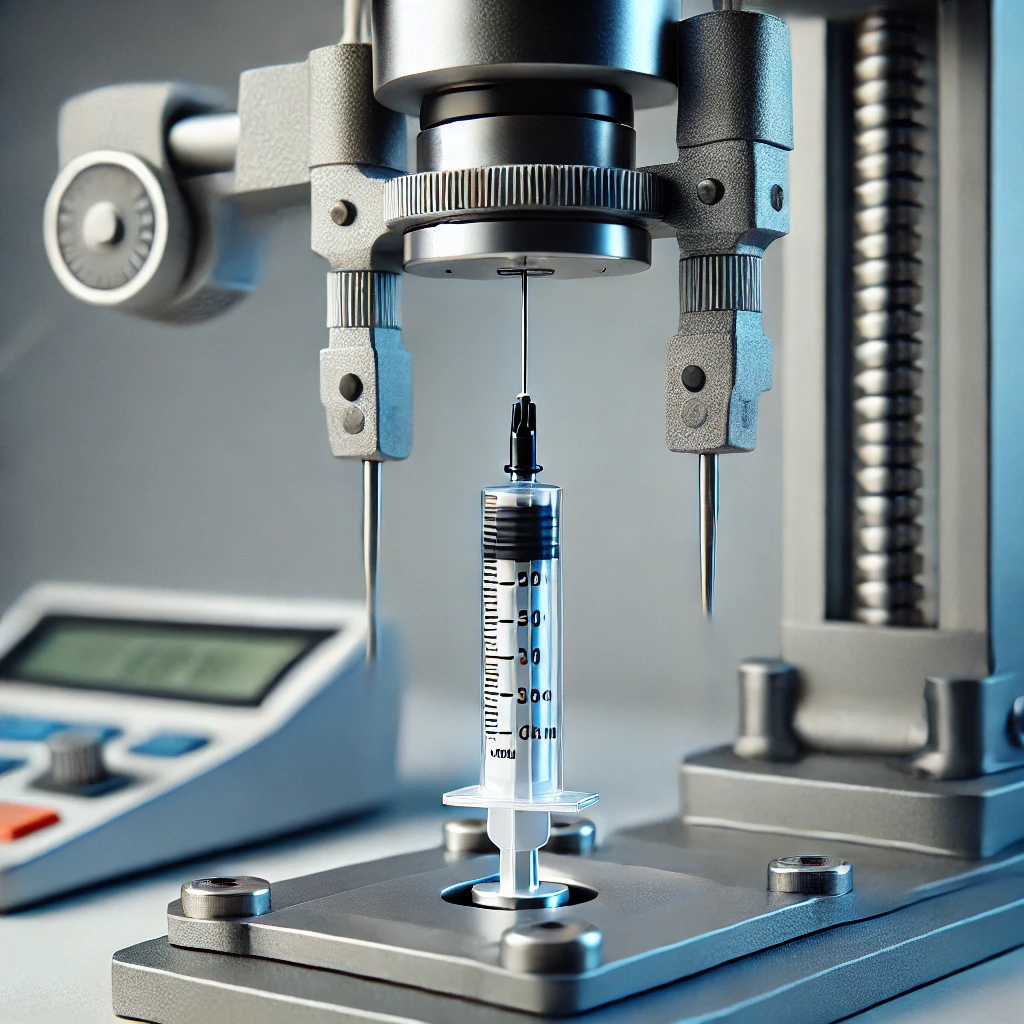The design verification tests for pre-filled syringes are critical in ensuring the device’s safety, functionality, and compliance with regulatory standards. ISO 11040 has different parts that describes the requirements for the barrel or plunger of a prefilled syringe. ISO 11040-8 lists the Requirements and test methods for finished prefilled syringes. FDA has published a guideline for design and development of glass syringes for delivering drug and biologics referring to ISO 11040 standard. The guideline can be found here.
The following tests are required to assess various aspects of the syringe’s performance, material compatibility, and its ability to reliably deliver the intended drug dosage.
1. Dose Accuracy and Precision
- Objective: Ensure that the syringe delivers the exact amount of medication as intended.
- Testing: Multiple syringes are filled and tested to confirm that each delivers the precise volume of drug without under or over-dosing.
- Importance: Accurate dosing is critical for drug efficacy and patient safety, especially for medications with narrow therapeutic windows.
2. Sterility Testing
- Objective: Confirm that the pre-filled syringe maintains sterility throughout its shelf life and before use.
- Testing: Sterility tests are performed on the finished product using microbiological methods, such as sterility testing in culture media or direct inoculation.
- Importance: Ensuring sterility is essential to prevent contamination that could lead to infections or compromised patient safety.
3. Particulate Matter Testing
- Objective: Ensure that the pre-filled syringe is free of particulate contamination.
- Testing: Visual and microscopic analysis is conducted to detect any particulate matter that might have entered the syringe during the manufacturing process.
- Importance: Particulate matter can cause harm if injected into the body, leading to blockages or adverse reactions.
- It is also important to understand the particulate caused by silicone oil in the syringe.
4. Container Closure Integrity
- Objective: Confirm that the syringe maintains its integrity and protects the drug from contamination or leakage over time.
- Testing: Methods like dye ingress testing, vacuum decay testing, or high voltage leak detection are used to ensure the closure system (cap, stopper, plunger) is properly sealed.
- Importance: A secure closure ensures that the drug remains sterile and stable throughout the shelf life of the syringe.
5. Needle Performance and Safety Features
5.1. Needle penetration testing
5.2. Pull-off force testing of the tip cap or the needle shield
5.3. Needle lubrication amount
- Objective: Verify that the needle performs as intended and that any safety features, such as needle shields or retractable mechanisms, function correctly.
- Testing: The needle’s sharpness, needle penetration force, needle lubrication amount, and pull-off force of the tip cap or needle shield is evaluated for ease of insertion, and safety features are tested to ensure proper needle protection after use.
- Importance: Proper needle design ensures safe administration and reduces the risk of needle-stick injuries for both healthcare providers and patients.
6. Glide-force Testing
- Objective: Assess the force required to depress the plunger and deliver the drug. This is called glide force and helps to assess the lubrication
- Testing: This involves measuring the force required to initiate and maintain movement of the plunger under various conditions (temperature, viscosity of the drug, etc.).
- Importance: The force should be low enough to allow easy administration but sufficient to deliver the drug completely without failure.
7. Breakage Resistance
- Objective: Ensure that the syringe, especially if made from glass, can withstand mechanical stresses without breaking.
- Testing: Mechanical tests are performed to assess the syringe’s ability to resist breakage when subjected to pressure, dropping, or other stress conditions.
- Importance: Syringes must maintain their integrity during handling, transportation, and use to avoid injury and drug waste.
8. Drug Stability Testing
- Objective: Verify that the drug remains stable in the pre-filled syringe over the intended shelf life.
- Testing: Stability testing is conducted to monitor chemical, physical, and microbiological stability over time under different environmental conditions (light, temperature, humidity).
- Importance: Ensuring drug stability is essential to maintain its efficacy, safety, and compliance with regulatory standards.
- Understanding the impact of silicone oil on the drug stability is also key
9. Extractables and Leachables Testing
- Objective: Determine if any materials from the syringe components (plunger, stopper, needle, etc.) leach into the drug solution over time.
- Testing: Analytical chemistry techniques are used to detect any harmful substances that could potentially migrate into the drug from the syringe materials.
- Importance: This ensures that the materials used in the syringe do not interact with or contaminate the drug formulation.
10. Labeling and Marking Durability
- Objective: Verify that labels remain intact, legible, and adherent to the syringe throughout its usage.
- Testing: Labels are exposed to handling, friction, moisture, and environmental factors to test their durability and legibility.
- Importance: Clear and durable labeling is important for correct dosage, drug identification, and regulatory compliance.
11. Usability/Human Factors Testing
- Objective: Assess the syringe’s ease of use and user safety in real-world scenarios.
- Testing: Simulated use testing with healthcare professionals and patients to identify potential usability issues, such as injection force, ease of handling, and operating safety mechanisms.
- Importance: Human factors testing ensures that the syringe is intuitive and easy to use, reducing the risk of user errors, especially for self-administration.
12. Compatibility Testing (Drug and Syringe)
- Objective: Ensure the materials of the syringe (plunger, barrel, needle, etc.) are compatible with the drug formulation.
- Testing: Compatibility studies are conducted to ensure there is no interaction between the drug and the syringe components that could affect drug stability or syringe performance.
- Importance: Maintaining drug stability and syringe functionality is crucial for long-term storage and patient safety.
These design verification tests are essential to ensure that pre-filled syringes meet safety, efficacy, and regulatory requirements. They are critical steps in bringing a high-quality, reliable combination product to market.
